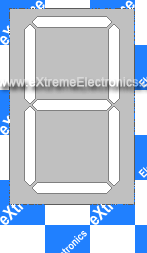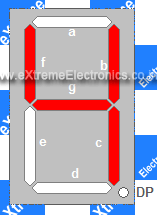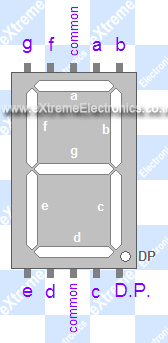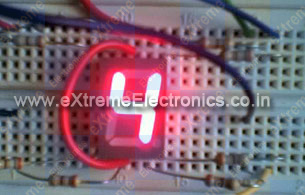Seven segment displays are very common for electronic product to display numerical output. Many common devices like calculators, watches, electronic weighing scales,ovens etc use them. You must have also seen lifts display the current floor numbers in seven segment displays. So in this article I will show you how to use 7-Segment displays in your own projects.
Fundamentals
A seven-segment display is so named because it is divided into seven different segments that can be switched on or off. The different combination of these segments switched on produces different English numbers. The display also has a decimal point.
 |
Fig: Seven Segment Display |
 |
Fig: '4' |
The figure shows a seven segment display and the names of the various segments. For example if you want to display number 4 then segments that will be ‘on’ are {f,g,b,c} while rest are ‘off’.Basically the seven segments are just LEDs. The one common end of all the leds are connected while the rest are available. Depending on whether anode or cathode of all the leds are common they are of two types.
1) Common anode 2)Common cathode
Fig: Common Cathode Type |
PIN Configuration
Now you know the basic of these displays, to use them you should know the pin configuration of the commercially available displays. As you must have guessed these displays should have nine pin( one for each segment + decimal point +common) but the available modules have two pins for common. They are internally connected. So they have total of 10 PINs.
 |
Fig: Pin Configuration |
 |
Fig: A seven segment display |
Interfacing with MCU
Interfacing these displays are same as interfacing LEDs with MCU. You need 7 MCU port pins to control them. If you also want to control the decimal point you need one extra pin. The connection is simple.
Fig: Connection with MCU |
Here I have interfaced a common anode(+) 7 segment display with PORTD of AVR.If you have made the “home made avr dev board” then you can easily connect this to PORTD of the board by using 8PINconnectors. The segments will be "on" when levels on the PORT is low, that is 0.
Programming
These displays are very easy to program in C. I am giving here a function, which you may use to display digits in 7-segment display. The sample program uses the function to continuously display digits from 0-9 and then repeating the sequence.
© 2011 Electroclub


 03:58
03:58
 technoclub
technoclub






0 comments:
Post a Comment